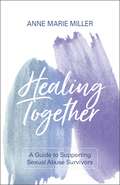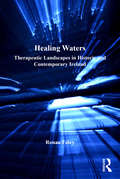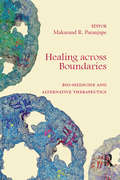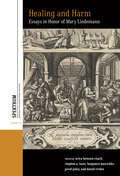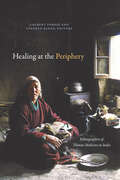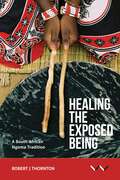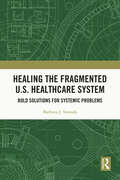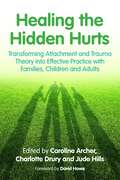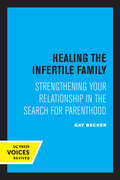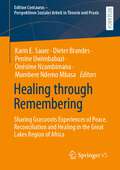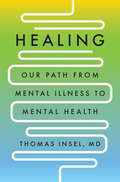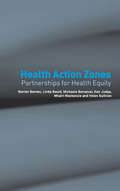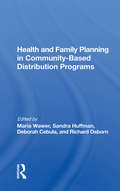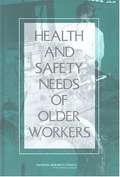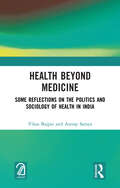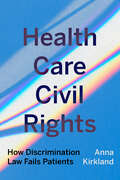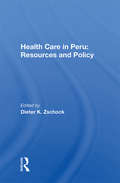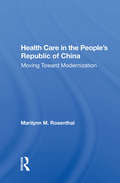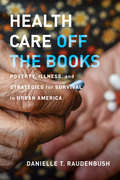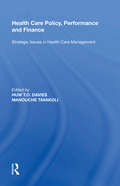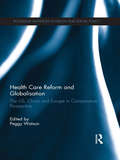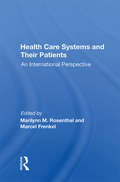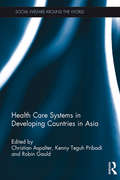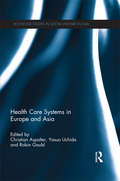- Table View
- List View
Healing Together: A Guide to Supporting Sexual Abuse Survivors
by Anne MillerSex is such an intimate topic historically wrapped in shame and when someone shares they were sexually abused, we may not know how to respond.With recent #MeToo and #ChurchToo movements, we are learning just how many men, women, boys, and girls have suffered sexual abuse at the hands of a trusted person, often family members or leaders in the church. Sexual abuse is rampant in modern society and now--sometimes many years later--sexual abuse survivors are sharing their stories.Anne Marie Miller is a survivor of childhood clergy sexual abuse and has shared her journey toward healing with audiences all over the world. After speaking with thousands of survivors and their loved ones, she saw the need for a fundamental and practical guide for helping supporters of sexual abuse survivors understand the basics of abuse, trauma, healing, and hope. Drawing from her own experience as a survivor and evidence-based research, Anne addresses these questions and more in Healing Together:What is sexual abuse?How can I help survivors?Who are predators and how do they groom victims?How does trauma affect survivors?What happens when someone doesn't remember the details of their abuse?How does abuse wound the physical, emotional, and spiritual health of people who have been abused?When and how should authorities be contacted?How do you talk to your children about sexual abuse?What are the warning signs of abuse?Is healing possible?Whether you are a spouse, a family member, a friend, or a church leader looking for easy-to-navigate resources to understand and support sexual abuse survivors, you'll find answers and hope in these pages.
Healing Waters: Therapeutic Landscapes in Historic and Contemporary Ireland (Geographies of Health Series)
by Ronan FoleyBringing together a range of different place-studies, including holy wells, spa towns, Turkish baths and sweat-houses, sea-bathing and the modern spa, this book investigates associations between water, health, place and culture in Ireland. It is informed by a humanistic approach, showing how health and place are socially and culturally constructed and how health is embodied, experienced and enacted in place. In addition, the work argues that an understanding of health and place must also consider the historical, societal and cultural orthodoxies that shape and produce those places.
Healing across Boundaries: Bio-medicine and Alternative Therapeutics
by Makarand R. ParanjapeThis unique volume initiates a dialogue between bio-medicine and alternative therapeutics. Undertaking a multidisciplinary exploration of the science and spirituality of healing and wellness, it offers varied perspectives from doctors, medical researchers, Ayurvedic practitioners, philosophers, psychologists, sociologists, and cultural critics. It expands the horizons of health sciences in engaging with diverse traditions — bio-medicine, Ayurveda, Siddha, and Jaina bio-ethics. The book will interest scholars and researchers in social and community medicine, biological sciences, sociology and social anthropology, as well as cultural studies.
Healing and Harm: Essays in Honor of Mary Lindemann (Spektrum: Publications of the German Studies Association #29)
by Erica Heinsen-Roach, Stephen A. Lazer, Benjamin Marschke, Jared Poley, and Daniel RichesProfessor Mary Lindemann inspired several generations of historical researchers in early modern history and culture. She has served as president of the German Studies Association and the American Historical Association and is the author of pathbreaking scholarly work in the history of medicine, urban space, diplomacy, and of women. In honor of her scholarship, service, and dedication, Healing and Harm gathers a group of leading scholars that includes her students, contemporaries, and those who have been inspired by her work to continue Lindemann’s prolific arguments and observations on early modern, central European and German history and culture.
Healing at the Periphery: Ethnographies of Tibetan Medicine in India
by Laurent Pordié and Stephan Kloos, EditorsIndia has long occupied an important place in Tibetan medicine's history and development. However, Indian Himalayan practitioners of Tibetan medicine, or amchi, have largely remained overlooked at the Tibetan medical periphery, despite playing a central social and medical role in their communities. Power and legitimacy, religion and economic development, biomedical encounters and Indian geopolitics all intersect in the work and identities of contemporary Himalayan amchi. This volume examines the crucial moment of crisis and transformation that occurred in the early 2000s to offer insights into the beginnings of Tibetan medicine's professionalization, industrialization, and official recognition in India and elsewhere. Based on fine-grained ethnographic studies in Ladakh, Zangskar, Sikkim, and the Darjeeling Hills, Healing at the Periphery asks how the dynamics of capitalism, social change, and the encounter with biomedicine affect small communities on the fringes of modern India, and, conversely, what local transformations of Tibetan medicine tell us about contemporary society and health care in the Himalayas and the Tibetan world.Contributors. Florian Besch, Calum Blaikie, Sienna R. Craig, Barbara Gerke, Isabelle Guérin, Kim Gutschow, Pascale Hancart Petitet, Stephan Kloos, Fernanda Pirie, Laurent Pordié
Healing from Hate: How Young Men Get Into--and Out Of--violent Extremism
by Michael KimmelBy the time Matthias was in seventh grade, he felt he’d better belong to some group, lest he be alone and vulnerable. The punks and anarchists were identifiable by their tattoos and hairstyles and music. But it was the skinheads who captured his imagination. They had great parties, and everyone seemed afraid of them. “They really represented what it meant to be a strong man,” he said. What draws young men into violent extremist groups? What are the ideologies that inspire them to join? And what are the emotional bonds forged that make it difficult to leave, even when they want to? Having conducted in-depth interviews with ex–white nationalists and neo-Nazis in the United States, as well as ex-skinheads and ex-neo-Nazis in Germany and Sweden, renowned sociologist Michael Kimmel demonstrates the pernicious effects that constructions of masculinity have on these young recruits. Kimmel unveils how white extremist groups wield masculinity to recruit and retain members—and to prevent them from exiting the movement. Young men in these groups often feel a sense of righteous indignation, seeing themselves as victims, their birthright upended in a world dominated by political correctness. Offering the promise of being able to "take back their manhood," these groups leverage stereotypes of masculinity to manipulate despair into white supremacist and neo-Nazi hatred. Kimmel combines individual stories with a multiangled analysis of the structural, political, and economic forces that marginalize these men to shed light on their feelings, yet make no excuses for their actions. Healing from Hate reminds us of some men's efforts to exit the movements and reintegrate themselves back into society and is a call to action to those who make it out to help those who are still trapped.
Healing the Exposed Being: The Ngoma healing tradition in South Africa
by Robert ThorntonThis ethnography explores the Ngoma healing tradition as practiced in eastern Mpumalanga, South Africa. ‘Bungoma’ is an active philosophical system and healing practice consisting of multiple strands, based on the notion that humans are intrinsically exposed to each other and that this is the cause of illness, but also the condition for the possibility of healing. This healing seeks to protect the ‘exposed being’ from harm through augmenting the self. Unlike Western medicine, it does not seek to cure physical ailments but aims to prevent suffering by allowing patients to transform their personal narratives of Self. Like Western medicine, it is empirical and is presented as a ‘local knowledge’ that amounts to a practical anthropology of human conflict and the environment. The book seeks to bring this anthropology and its therapeutic applications into relation with global academic anthropology by explaining it through political, economic, interpretive, and environmental lenses
Healing the Fragmented U.S. Healthcare System: Bold Solutions for Systemic Problems
by Barbara SowadaThrough a systems perspective, this insightful book challenges the current state of healthcare in the United States, arguing for overarching reforms that would lead ultimately to universal healthcare coverage across the country.Written by the president of the board of trustees of a rural hospital, the book highlights the chronic issues facing American healthcare today, namely high costs, poor health outcomes, excessive health inequalities, and a lack of trust. It uses systems thinking principles – used in hospitals themselves to improve efficiency, quality, and safety of care – to show how the fragmented system could be transformed by addressing these issues holistically. The book also gives suggestions for rebuilding trust, respect, and mutual cooperation, issues which are also critical in healing the current system.Grounded in the author’s direct experience in facing the challenges of dealing with a fragmented system in America today, this perceptive book will interest graduate students in healthcare administration, policy, or leadership programs, as well as scholars in these and related fields.
Healing the Hidden Hurts: Transforming Attachment and Trauma Theory into Effective Practice with Families, Children and Adults
by David Howe Caroline Archer Christine Gordon Helen O'Shea Hannah Fryer Victoria Drury Tamara Gordon Jonny Matthew Helen Jury Marie Martin Kate Mcinnes Charlotte Drury Tricia Skuse Jude Hills Lisa Waycott Viv Norris Ann Cartwright Emma Birch Claire Carbiss Elaine Simpson Jane MacnamaraHealing the Hidden Hurts: Transforming Attachment and Trauma Theory into Effective Practice with Families, Children and Adults provides a unique collection of professional and personal responses to the challenges that arise in dealing with attachment difficulties. With contributions from social workers, adoptive parents, adoptees, psychologists, therapists, counsellors and other related professionals, this book provides a varied and expansive approach to explaining attachment theory. The authors speak from personal experience to deliver explanations of theory, how they relate to practice and to provide practical guidance on how to improve the physical, emotional and psychological development of children in care across a broad range of professional settings. This book provides valuable insights relevant to practitioners within the fields of social work, health, education, the criminal justice system and any independent and voluntary sectors working with children and families.
Healing the Infertile Family: Strengthening Your Relationship in the Search for Parenthood
by Gay BeckerUnlike most infertility books that focus on medical treatment, Healing the Infertile Family examines the social and emotional problems experienced by couples confronting infertility and suggests how they can be alleviated. In this updated edition, Gay Becker discusses her most recent study of couples experiencing infertility and offers guidelines for resolution of this common problem that will enable couples to face the future with hope. This title is part of UC Press's Voices Revived program, which commemorates University of California Press’s mission to seek out and cultivate the brightest minds and give them voice, reach, and impact. Drawing on a backlist dating to 1893, Voices Revived makes high-quality, peer-reviewed scholarship accessible once again using print-on-demand technology. This title was originally published in 1990.
Healing through Remembering: Sharing Grassroots Experiences of Peace, Reconciliation and Healing in the Great Lakes Region of Africa (Edition Centaurus - Perspektiven Sozialer Arbeit in Theorie und Praxis)
by Karin E. Sauer Penine Uwimbabazi Dieter Brandes Onésime Nzambimana Mumbere Ndemo MbasaThis educational handbook displays grassroots experiences of peace, reconciliation, and healing in the Great Lakes region of Africa, in which Burundian, Congolese, and Rwandan authors share their understandings and practices of Memory Work. They committed to do so in a joint Participatory Action Research Team together with German facilitators. The team members ‘opened their archives’ on the traumatizing effects of the severe conflicts that each of these countries experienced. Their learnings and findings from this research process are collected in this book, which aims to resolve remaining tensions resulting from past experiences. Displaying a variety of strategies that lead to a Healing of Memories, it is high time to integrate such discourses into a mainly Western-European-centered scientific community. In this way, the book aims to fill the academic void regarding the German-colonial legacy of violence in the three neighboring countries, which was fueled under colonial rule. As such, this book is central to current discourses on the decolonization of science in terms of authorship, research ethics, and methods.
Healing: Our Path from Mental Illness to Mental Health
by Thomas InselA bold, expert, and actionable map for the re-invention of America&’s broken mental health care system.&“Healing is truly one of the best books ever written about mental illness, and I think I&’ve read them all." —Pete Earley, author of CrazyAs director of the National Institute of Mental Health, Dr. Thomas Insel was giving a presentation when the father of a boy with schizophrenia yelled from the back of the room, &“Our house is on fire and you&’re telling me about the chemistry of the paint! What are you doing to put out the fire?&” Dr. Insel knew in his heart that the answer was not nearly enough. The gargantuan American mental health industry was not healing millions who were desperately in need. He left his position atop the mental health research world to investigate all that was broken—and what a better path to mental health might look like. In the United States, we have treatments that work, but our system fails at every stage to deliver care well. Even before COVID, mental illness was claiming a life every eleven minutes by suicide. Quality of care varies widely, and much of the field lacks accountability. We focus on drug therapies for symptom reduction rather than on plans for long-term recovery. Care is often unaffordable and unavailable, particularly for those who need it most and are homeless or incarcerated. Where was the justice for the millions of Americans suffering from mental illness? Who was helping their families? But Dr. Insel also found that we do have approaches that work, both in the U.S. and globally. Mental illnesses are medical problems, but he discovers that the cures for the crisis are not just medical, but social. This path to healing, built upon what he calls the three Ps (people, place, and purpose), is more straightforward than we might imagine. Dr. Insel offers a comprehensive plan for our failing system and for families trying to discern the way forward. The fruit of a lifetime of expertise and a global quest for answers, Healing is a hopeful, actionable account and achievable vision for us all in this time of mental health crisis.
Health Action Zones: Partnerships for Health Equity
by Marian Barnes Helen Sullivan Linda Bauld Ken Judge Michaela Benzeval Mhairi MackenzieHealth Action Zones (HAZ) were one of the earliest and most prominent area-based initiatives launched by the New Labour government in England soon after it came to power in 1997. Written by members of the team undertaking the national evaluation of HAZ, this book examines the initiative’s development and impact from a variety of perspectives. It outlines important features of the social, policy and evaluative environment within which HAZ were established and discusses enduring themes such as building and developing capacity with diverse and unequal partners within complex policy systems. Multidisciplinary in nature, the book provides in-depth analysis of a key policy initiative, offering guidance on how best to design, implement and evaluate future initiatives intended to deal with fundamental social problems.
Health And Family Planning In Community-based Distribution Projects
by Richard Osborn Maria Wawer Sandra Huffman Deborah CebulaThe authors of this book address the major issues involved in developing and evaluating community-based delivery (CBD) healthcare services administered by nonmedical workers in developing countries. Ranging from a general discussion of integrated community-based programs to the prescription of dose regimens that nonmedical personnel can use in field situations, the contributions cover such topics as nutrition intervention, antihelminthics distribution, oral rehydration therapy, and the efficacy of existing programs designed to train those who administer these services.
Health And Saffty Needs Of Older Workers
by National Research Council of the National AcademiesMirroring a worldwide phenomenon in industrialized nations, the U.S. is experiencing a change in its demographic structure known as population aging. Concern about the aging population tends to focus on the adequacy of Medicare and Social Security, retirement of older Americans, and the need to identify policies, programs, and strategies that address the health and safety needs of older workers. Older workers differ from their younger counterparts in a variety of physical, psychological, and social factors. Evaluating the extent, causes, and effects of these factors and improving the research and data systems necessary to address the health and safety needs of older workers may significantly impact both their ability to remain in the workforce and their well being in retirement. Health and Safety Needs of Older Workers provides an image of what is currently known about the health and safety needs of older workers and the research needed to encourage social polices that guarantee older workers a meaningful share of the nation’s work opportunities.
Health Beyond Medicine: Some Reflections on the Politics and Sociology of Health in India
by Vikas Bajpai Anoop SarayaThis book integrates the concept of healthcare with larger social determinants such as caste, class, gender, religion, and ethnicity. It presents a history of the development of health services, discusses the recommendations of the landmark report of the Bhore Committee that laid the foundations of the public health services in independent India, and traces the evolution of this system through social, economic, and political structures. The subject matter of this book also includes: The Play of Religion in the Delivery of Rural Health Care Of the Relationship Between Population and Development Pay for Performance Programmes in Health Care Print edition not for sale in South Asia (India, Sri Lanka, Nepal, Bangladesh, Pakistan or Bhutan)
Health Care Civil Rights: How Discrimination Law Fails Patients
by Anna KirklandA free ebook version of this title is available through Luminos, University of California Press’s Open Access publishing program. Visit www.luminosoa.org to learn more. Focusing on the provision of gender-affirming care, Health Care Civil Rights analyzes the difficulties and potential of discrimination law in healthcare settings. The application of civil rights law could be a powerful response to health inequalities in the US, but conservative challenges and the complex and fragmented nature of our health care system have limited the real-world success of this strategy. Revealing deep divides and competing interests that reverberate through patient experiences, insurance claims, and courtroom arguments, Anna Kirkland explains what health care civil rights are, how they work in theory and practice, and how to strengthen them.
Health Care In Peru: Resources And Policy
by Dieter K. ZschockThis book examines an important aspect of health care in Peru in considerable depth, based on intensive analysis of data from Peruvian sources. It offers a number of recommendations that can help bring the allocation of health sector resources into line with the country's health care policy. .
Health Care In The People's Republic Of China: Moving Toward Modernization
by Marilynn M RosenthalThe Chinese health care system is deeply rooted in a traditional, agricultural way of life, but since the late 1970s it has been increasingly influenced by the dynamics of a modernizing society. Dr. Rosenthal, using data collected through interviews, small-scale surveys, and the Chinese press, examines how Chinese medicine is being transformed. She
Health Care Off the Books: Poverty, Illness, and Strategies for Survival in Urban America
by Danielle T. RaudenbushMillions of low-income African Americans in the United States lack access to health care. How do they treat their health care problems? In Health Care Off the Books, Danielle T. Raudenbush provides an answer that challenges public perceptions and prior scholarly work. Informed by three and a half years of fieldwork in a public housing development, Raudenbush shows how residents who face obstacles to health care gain access to pharmaceutical drugs, medical equipment, physician reference manuals, and insurance cards by mobilizing social networks that include not only their neighbors but also local physicians. However, membership in these social networks is not universal, and some residents are forced to turn to a robust street market to obtain medicine. For others, health problems simply go untreated. Raudenbush reconceptualizes U.S. health care as a formal-informal hybrid system and explains why many residents who do have access to health services also turn to informal strategies to treat their health problems. While the practices described in the book may at times be beneficial to people’s health, they also have the potential to do serious harm. By understanding this hybrid system, we can evaluate its effects and gain new insight into the sources of social and racial disparities in health outcomes.
Health Care Policy, Performance and Finance: Strategic Issues in Health Care Management
by Manouche TavakoliPolicy, performance and finance are the issues currently headlining the healthcare agenda and are likely to remain so for the foreseeable future. Drawing on experiences from around the world, this essential collection examines the key strategic issues facing health services and analyzes the policy implications of leading new research. The volume brings together 16 newly-commissioned studies from leading experts in health studies, in particular: policy, economics, health care management and health services research. International in perspective and scope, it draws on empirical evidence from East and West Europe, Canada, New Zealand and the Middle East. Themes covered include: health policy and technology assessment, policy and performance, international policy innovation, and organizational innovation. This ground-breaking collection will prove a valuable guide for policy makers, managers, practitioners, researchers and students.
Health Care Reform and Globalisation: The US, China and Europe in Comparative Perspective
by Watson PeggyIn the post-Cold War, post financial crisis era, health care is an issue of critical political, personal and economic concern. In the US, plans to address a troubled health care model were met by vocal opposition. In the UK and post-communist Europe, attempts to introduce aspects of that model have resulted in controversy and violent protests, while China and Russia have recently backpedalled on marketising reforms. This innovative book provides a timely analysis addressing the many dimensions of radical health care change. Bringing together three major geopolitical regions with strikingly different recent histories, this international cast of contributors, examines reform in US, China and Europe within a single study frame. They look at the processes that have been involved when countries with such diverse starting points try to move towards a globally shared health care framework. An underlying theme running through the chapters is access to care, and how it is shaped by moral economies, by what can be said and known, and by political and economic power. Health Care Reform and Globalisation confronts the interpretations and experiences of patients, professionals, and politicians of health care transformation in practice. It will be of interest to scholars from a range of diverse disciplinary backgrounds, including public health, anthropology, area studies, sociology, politics, social policy, geography and economics.
Health Care Systems And Their Patients: An International Perspective
by Marilynn M. Rosenthal Marcel FrenkelThis book provides an examination of the American health care system, a benchmark for cost-containment efforts, exploring two worlds: that of cost containment and that of the patient experience. It emphasises on the quality of care as perceived by the individual patient.
Health Care Systems in Developing Countries in Asia (Social Welfare Around the World)
by Robin Gauld Christian Aspalter Kenny Teguh PribadiFor the last two decades, major Asian economies have successfully kept their economic growth momentum going. Now, as these economies are entering a new phase of economic growth, more attention is being paid to their respective states of social development, especially the provision and the expansion of social security and, in particular, health care. Academic study of the development of health care in developing countries has been for the most part neglected by the literature, and in-depth country case studies that are directly comparable on a one-to-one basis have not yet been conducted in a systematic manner. This book volume also proposes a new stance on health policy and the health care policy paradigm, one that focuses on "saving lives" from premature death, as well as illness, accidents, misery and poverty, based on the normative theory of developmental social policy (DSP). This groundbreaking book will therefore serve as a valuable reference volume for health policy, social policy and public policy experts, social development experts, health and development economists, health sociologists, social workers, government administrators as well as other medical and health professionals and academics.
Health Care Systems in Europe and Asia (Routledge Studies in Social Welfare in Asia)
by Yasuo Uchida Robin Gauld Christian AspalterThis book addresses the global need for more comparative studies on health policy and health care systems, given the rise in recent decades of societal aging, modern mass diseases, economic globalization, and resulting permanent fiscal austerity of governments which have fundamentally altered the status quo of health care systems. The book examines the healthcare experiences of the most developed countries in Asia (Japan, South Korea, Taiwan and Singapore) and compares these with four of the most important health care systems in Europe (UK, France, Germany and Italy). Focusing on the public health care systems the contributors discuss the rising need for reforms in health care and health insurance administration, delivery systems, financing and overall health care policy strategies, particularly in fast-aging societies in Asia, and highly aged societies in Europe. This book will appeal to students and scholars of health care policy, health and social administration, social policy, public policy and social work. It will also provide a reference for professionals who need a view of the trajectory of public health financing in relation to changed and changing demographics and disease patterns.
